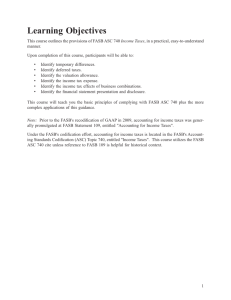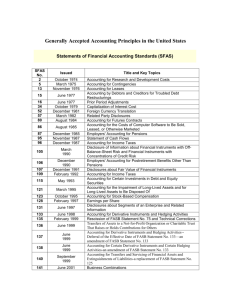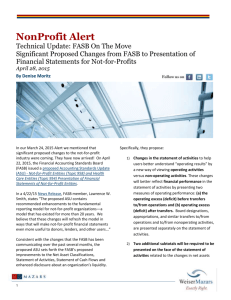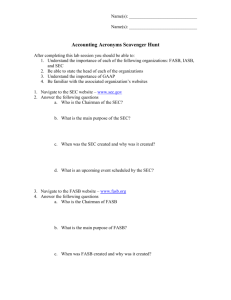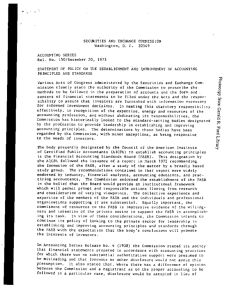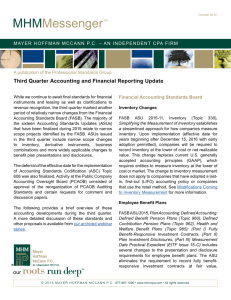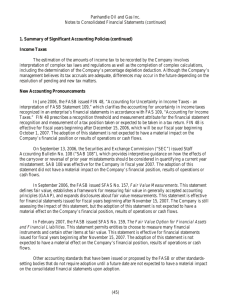Meeting Highlights - Private Company Financial Reporting Committee
advertisement
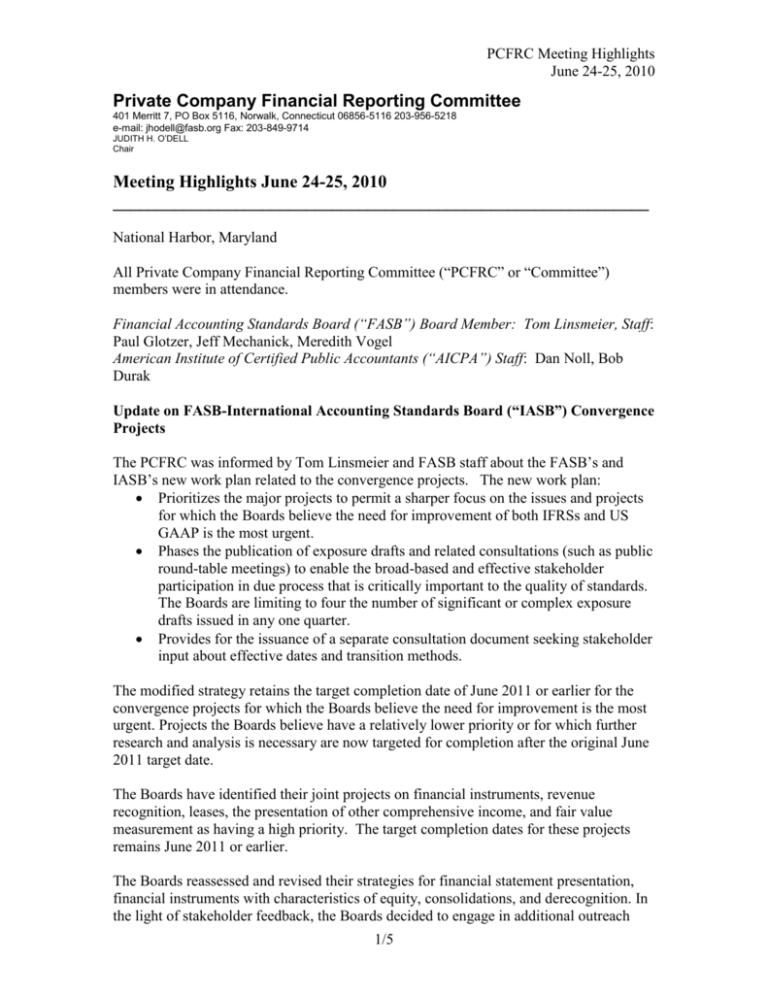
PCFRC Meeting Highlights June 24-25, 2010 Private Company Financial Reporting Committee 401 Merritt 7, PO Box 5116, Norwalk, Connecticut 06856-5116 203-956-5218 e-mail: jhodell@fasb.org Fax: 203-849-9714 JUDITH H. O’DELL Chair Meeting Highlights June 24-25, 2010 _____________________________________________________________ National Harbor, Maryland All Private Company Financial Reporting Committee (“PCFRC” or “Committee”) members were in attendance. Financial Accounting Standards Board (“FASB”) Board Member: Tom Linsmeier, Staff: Paul Glotzer, Jeff Mechanick, Meredith Vogel American Institute of Certified Public Accountants (“AICPA”) Staff: Dan Noll, Bob Durak Update on FASB-International Accounting Standards Board (“IASB”) Convergence Projects The PCFRC was informed by Tom Linsmeier and FASB staff about the FASB’s and IASB’s new work plan related to the convergence projects. The new work plan: Prioritizes the major projects to permit a sharper focus on the issues and projects for which the Boards believe the need for improvement of both IFRSs and US GAAP is the most urgent. Phases the publication of exposure drafts and related consultations (such as public round-table meetings) to enable the broad-based and effective stakeholder participation in due process that is critically important to the quality of standards. The Boards are limiting to four the number of significant or complex exposure drafts issued in any one quarter. Provides for the issuance of a separate consultation document seeking stakeholder input about effective dates and transition methods. The modified strategy retains the target completion date of June 2011 or earlier for the convergence projects for which the Boards believe the need for improvement is the most urgent. Projects the Boards believe have a relatively lower priority or for which further research and analysis is necessary are now targeted for completion after the original June 2011 target date. The Boards have identified their joint projects on financial instruments, revenue recognition, leases, the presentation of other comprehensive income, and fair value measurement as having a high priority. The target completion dates for these projects remains June 2011 or earlier. The Boards reassessed and revised their strategies for financial statement presentation, financial instruments with characteristics of equity, consolidations, and derecognition. In the light of stakeholder feedback, the Boards decided to engage in additional outreach 1/5 PCFRC Meeting Highlights June 24-25, 2010 and analysis before finalizing and publishing exposure drafts on financial statement presentation (including issues relating to discontinued operations) and financial instruments with characteristics of equity. The Boards believe that their consolidation requirements (including disclosures) relating to entities used as vehicles for securitization, structured investment, and other similar activities will substantially be converged as a result of their separate, yet co-operative standard-setting projects (the FASB recently amended its consolidation guidance and the IASB will finalize its consolidation project in 2010 as planned). For more information about the FASB’s and IASB’s work plan, go to http://www.fasb.org/cs/ContentServer?c=Document_C&pagename=FASB%2FDocument _C%2FDocumentPage&cid=1176156953931 Conceptual Framework Project – Reporting Entity Exposure Draft The PCFRC discussed the FASB’s exposure draft titled Conceptual Framework for Financial Reporting: The Reporting Entity and developed the following comment points and recommendations which will be sent to the FASB: The definition of a “reporting entity” in paragraph S1 of the Exposure Draft is in need of clarification and change. Only referring to equity investors, lenders, and other creditors in the definition fails to encompass other financial statement users. In addition, the current wording may suggest to some readers that many private companies would be scoped out of the definition. As such, the PCFRC will suggest revised wording. The PCFRC believes that in the private company sector flexibility is needed in determining the composition of a group reporting entity and in defining a circumscribed area of economic activity. A basis for determining the composition of a group reporting entity should take into account all relevant considerations. The legal ownership and composition of entities is important to the users of private company financial statements. For example, users may not have access to the cash flows of entities that may be consolidated into a potential group reporting entity but are outside the legal composition of the reporting entity. As such, including the assets, liabilities, operations, and cash flows of such an entity in the financial statements of the reporting entity would not be decision-useful to the user of the reporting entity’s financial information. 2/5 PCFRC Meeting Highlights June 24-25, 2010 The PCFRC believes that consolidated financial statements do not always provide useful information to private company equity investors, lenders, other capital providers, sureties, and insurers. As stated in the PCFRC’s July 18, 2008 letter to the FASB, private company financial reporting users’ needs appear to be diverse depending upon the nature of the user (e.g., lender, surety, venture capitalist) and their purposes. The PCFRC believes that stand-alone, parent-only financial statements should be allowed under generally accepted accounting principles (“GAAP”) for private companies. Dissenting Opinion (two PCFRC members dissented from the PCFRC’s recommendation about parent-only financial statements) These PCFRC members do not believe that stand-alone parent-only financial statements should be GAAP for private companies. These members think that not consolidating entities that are controlled by a parent company could mask potential risks and rewards to the consolidated group. The PCFRC believes that clarification and guidance is needed about when combining financial statements are appropriate. Often in the private company sector, an individual may own multiple entities. Uncertainty exists about what types of combined financial reporting are acceptable. . The PCFRC believes that the Reporting Entity portion of the Conceptual Framework should be completed before the FASB and IASB develop their standards on consolidation Note: The PCFRC issued its comment/recommendation letter to the FASB. The letter can be found at http://www.pcfr.org/downloads/PCFRC_final_letter_to_FASB_on_report_entity_ED_710.pdf Accounting for Financial Instruments The PCFRC discussed the FASB’s proposed Accounting Standards Update (“ASU”), Accounting for Financial Instruments and Revisions to the Accounting for Derivative Instruments and Hedging Activities. In discussing the proposed ASU, the PCFRC developed a table listing the most common financial instruments encountered at private companies, the proposed accounting for those financial instruments, and the PCFRC’s suggested accounting for those financial instruments. The table will be sent to Tom Linsmeier of the FASB and FASB staff for review and comment. Afterwards, the PCFRC will utilize the table in developing its comments and recommendations on the proposed ASU. The PCFRC will also use the table to help constituents better understand the proposed ASU and its implications for the private company sector. In addition to the table, the PCFRC will explore the idea of doing a webcast to help constituents comprehend the proposed new accounting requirements. Statement of Comprehensive Income 3/5 PCFRC Meeting Highlights June 24-25, 2010 The PCFRC reviewed the proposed FASB ASU, Statement of Comprehensive Income. Private company financial statement users on the Committee believe that the proposed ASU is an improvement to current financial reporting. The PCFRC’s task force on this project will study the proposed ASU further and develop a comment letter to the FASB. Revenue Recognition The PCFRC discussed the FASB’s proposed ASU, Revenue from Contracts with Customers and its implications to the private company sector. Tom Linsmeier suggested that the Committee avoid focusing on the proposed ASU’s implications to the construction industry because the FASB expects to receive significant input from individuals and organizations in that industry. Mr. Linsmeier also suggested that the PCFRC focus on whether or not the proposed ASU will be operational in the private company sector. Preliminary observations of the Committee included concern that the matching principle is not being followed in the proposed ASU and that the proposed ASU seems to be an improvement over the requirements of SOP 97-2, Software Revenue Recognition. The PCFRC decided to have each of its members run typical transactions they encounter through the proposed revenue recognition model and share the results with the Committee’s task force on this project. At its September meeting, the PCFRC will continue its work on the proposed ASU. Future Private Company Accounting Models The PCFRC met in a closed-door session with the staff of the AICPA/Financial Accounting Foundation (“FAF”)/National Association of State Boards of Accountancy (“NASBA”) Blue Ribbon Panel on private company accounting to review various models of the future of private company accounting that the panel is considering. Information about the panel is found at http://www.fasb.org/cs/ContentServer?c=Page&pagename=FASB%2FPage%2FSectionP age&cid=1176156684820 FAF Post-implementation Review – Goodwill Impairment Testing The PCFRC decided to recommend that the FAF conduct a post-implementation review on the accounting requirement to conduct annual goodwill impairment testing (ASC 350). The Committee is of the opinion that the impairment testing requirement imposes significant cost to private companies but provides no benefit to those who use their financial statements. In the private company sector, the testing is considered highly subjective and provides no predictive value. The PCFRC will issue a letter to FAF once the post-implementation review process is in place. Update on Other FASB Projects 4/5 PCFRC Meeting Highlights June 24-25, 2010 The PCFRC reviewed the progress and decisions made by the FASB on a number of projects, including: Financial Instruments with Characteristics of Equity Leases Fair Value Disclosure of Certain Loss Contingencies Consolidations Disclosures about an Employer’s Participation in a Multiemployer Plan Going Concern Disclosures about Credit Quality and the Allowance for Credit Losses Reporting Discontinued Operations Balance Sheet Offsetting Investment Properties Disclosure Framework Next PCFRC Meetings Tentative PCFRC meeting dates for 2010 are as follows: September 30 October 1 2010 (Cincinnati, Ohio) December 2-3, 2010 (Norwalk, Connecticut) 5/5



